By Jeff Kenney
NATIVE AMERICAN BEGINNINGS
The earliest Catholic presence in the Culver – Lake Maxinkuckee area grew from the efforts of French Jesuit priests, particularly those sent to the area from the mission established at Notre Dame. By the early 1800s, the local 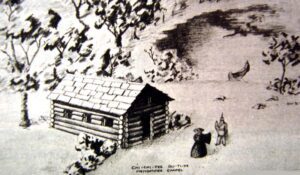 Potawatomi Indians (Native Americans) were largely Catholic, and the first church in Marshall County, Indiana, was a log cabin chapel between Culver and Plymouth which specifically served the village of Chief Menominee, but also the Potawatomi under Chief Nees-Wau-Ghee on the east shore of Maxinkuckee and Aubbeenaubbee on the south shore.
Potawatomi Indians (Native Americans) were largely Catholic, and the first church in Marshall County, Indiana, was a log cabin chapel between Culver and Plymouth which specifically served the village of Chief Menominee, but also the Potawatomi under Chief Nees-Wau-Ghee on the east shore of Maxinkuckee and Aubbeenaubbee on the south shore.
A historic marker on 12th Road north of Culver denotes the site of the chapel, which it says was built by the first priest ordained in the US, Fr. Theodore Stephen Baden.
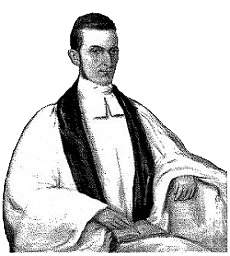 The last priest assigned to the chapel was a 27-year-old Frenchman named Fr. Benjamin Petit, who pressed for fair treatment of the Potawatomi being forced from the area by US government treaties. He accompanied more than 800 Potawatomi in Sept., 1838, in the infamous “Trail of Death” forced march from the Twin Lakes area to Kansas, dying as a result of fever contracted on the journey (he is buried under Notre Dame’s replica log cabin chapel).
The last priest assigned to the chapel was a 27-year-old Frenchman named Fr. Benjamin Petit, who pressed for fair treatment of the Potawatomi being forced from the area by US government treaties. He accompanied more than 800 Potawatomi in Sept., 1838, in the infamous “Trail of Death” forced march from the Twin Lakes area to Kansas, dying as a result of fever contracted on the journey (he is buried under Notre Dame’s replica log cabin chapel).
Following the departure of the Potawatomi, little Catholic activity took place specifically in Culver until the arrival of the families of Peter Keller and Joseph Busart, local Catholic pioneers and the first to hear local masses said in Culver proper, back in 1892, according to The Culver Citizen newspaper in 1955.
THE FIRST ST. MARY OF THE LAKE, 1897
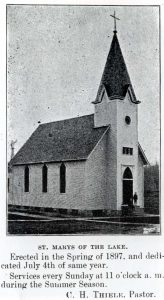 St. Mary of the Lake Catholic Church was first built in Culver in 1897, through the generosity of Thomas Sheerin, according to the Citizen. Sheerin was an Irish immigrant to the US and later an abolitionist whose son, Simon, had been editor of the Logansport Pharos Tribune and a clerk of the Indiana Supreme Court. Simon built a cottage on Lake Maxinkuckee near the site of the future Culver Inn, at today’s Culver Academies.
St. Mary of the Lake Catholic Church was first built in Culver in 1897, through the generosity of Thomas Sheerin, according to the Citizen. Sheerin was an Irish immigrant to the US and later an abolitionist whose son, Simon, had been editor of the Logansport Pharos Tribune and a clerk of the Indiana Supreme Court. Simon built a cottage on Lake Maxinkuckee near the site of the future Culver Inn, at today’s Culver Academies.
In those days St. Mary’s largely catered to the bustling summer traffic arriving by rail to Lake Maxinkuckee each weekend (as many as 7,000 people per weekend visited the lake to cool off in those pre-air conditioning days).
The Culver community at the time had few Catholics, though a number of year-round residents of Indiana cities like Logansport (the home of Sheerin’s family) and Indianapolis either had cottages on the lake or visited frequently.
The original St. Mary’s was conveniently located a few short blocks from the train station and busy town park and beach, on the northeast corner of what is today Lake Street and Lake Shore Drive (an empty lot today occupies the spot).
A lightning bolt to the steeple started the September, 1903 fire that destroyed the building and effectively ended St. Mary’s as an active parish with a church as its base. Little coverage of the fire was featured in the local newspaper, which noted the church had not been used since the busy tourist season ended, implying it sat largely empty outside the summer months.
Mass was celebrated sporadically in Culver in the 40 years following, sometimes in the lower level of the Carnegie library on Main Street, and apparently at times in the El Rancho movie theater on Lake Shore Drive.
FR. LENK AND THE ‘PRESSURE COOKER CHURCH’
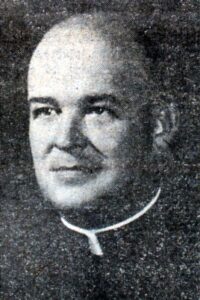 It wasn’t until 1948, with the arrival of Father Joseph Lenk, that St. Mary of the Lake began to take shape as the parish it is today.
It wasn’t until 1948, with the arrival of Father Joseph Lenk, that St. Mary of the Lake began to take shape as the parish it is today.
From a biographical sketch of Fr. Lenk in the July 2, 1954 Culver Citizen:
Father Lenk was born in Fort Wayne. He prepared for the priesthood at St. Joseph’s College, St. Mary’s College, and Notre Dame University, with theological studies at Mr. St. Mary’s Theological Seminary at Norwood, Ohio.
He was ordained to the priesthood by Archbishop John Francis Noll, D. D. in the Cathedral at Fort Wayne on June 3, 1939.
He had served for three years as assistant pastor at St. Lawrence Church at Muncie when he entered the U. S. Army as a chaplain. (Tour of duty, foreign service: Chaplain School at Harvard University: appointment with the 91st Infantry Division on the West Coast. Then overseas duty in M.T.O., North Africa and Italy. In recognition of the work of the chaplains of the 5th Army after the armistice was signed, he enjoyed a trip to Athens, Greece, Cairo, Egypt, and spent a month in the Holy Land.)
In March 1945, Father Lenk was separated from the service with the rank of Major. He became a staff member of the Veterans Administration hospital at Hines, Ill., becoming senior chaplain the same month.
In 1947 Father Lenk was appointed first assistant to Msgr. John S. Sabo, the Catholic dean of the South Bend area at Our Lady Church. In September 1948, Father Lenk was appointed first resident pastor of St. Mary’s Mission Church in Culver with the work of establishing a Catholic parish and church in this community.
In December of 1948, Fr. Lenk oversaw the construction of a “new” St. Mary of the Lake Church at the corner of College Ave. and Plymouth Street, the present location of St. Mary’s.
The Oct. 13, 1948 Culver Citizen contains some interesting facts about the parish at the time: “Ground will be broken within the next two weeks for the erection of a new church structure for the Culver Catholic parish, now officially known as Immaculate Heart of Mary Church, according to Rev. Julian L. Lubo, pastor…the decision was made at a meeting of 55 members and friends of the parish at the East Shore Inn Sunday night. Also attending the gathering were Rev. Jude, superior of Divine Heart College at Donaldson, and Rev. Bernard Rotterman, superior of the major seminary at Hales Corners, Wisc.
“The church will be built on the land the parish purchased some time ago at the corner of College Avenue and Plymouth Street, which is 180 by 170 feet in size, and will face on the former street. The central structure will be 80 feet long and 36 feet wide, with a parish hall on one side and a rectory on the other, both adjacent to the church proper. Each of these will be 24 by 52 feet in size, with the parish hall including a kitchen and restrooms besides the main social room. The rectory will be a complete home for the parish priest.”
The article goes on to describe a structure closer to our present-day building than what wound up being built: the plan was for a brick building with a Romanesque interior and “plaster walls in panels and Doric pilasters.”
 Obviously things changed between the plan and what finally happened. The Quonset hut church which came into being had its front doors facing Plymouth Street, unlike today’s St. Mary’s, which faces College Ave.
Obviously things changed between the plan and what finally happened. The Quonset hut church which came into being had its front doors facing Plymouth Street, unlike today’s St. Mary’s, which faces College Ave.
It is also interesting to note that the parish priest at the time was not Fr. Joseph Lenk, who would lead the building project, but Fr. Lubo. If the parish was actually named “Immaculate Heart of Mary,” this was a temporary change…it had been “St Mary of the Lake” since at least 1897.
It seems likely that funds weren’t sufficient to construct the envisioned church building. Instead, Fr. Lenk’s military background likely contributed to the original church’s use of a sheet metal military Quonset hut as its first building, probably with plans to raise money to build a more permanent and suitable church building.
By Dec. 3, 1948, Fr. Lenk had arrived in Culver, having been sent — according to the Today’s Catholic Diocesan newspaper in July, 1995 — by Bishop John F. Noll, partly at the request of the Culver Military Academy administration, as CMA had an increasingly Catholic populace in the form of Latin American students. Lenk wrote the following to Bishop Noll:
“Just a few lines to inform you of our process at Culver. Monday evening of this week I invited the members of the parish to the rectory. After discussions of our problems at Culver in regard to the need for a church, twenty one of the families expressed their desire to begin construction of the church immediately on the plans I had shown you.
“W.R. Baker from South Bend is our architect, and David Burns from Culver, Indiana is our contractor. Labor is rather cheap in Culver and it is very likely that the total cost of the new church will not exceed $10,000.00.
“I have not seen your friend, Mr. Radign, of Gary, Indiana in regard to furniture. I have a stove to cook on, a table to eat from, and a bed to sleep in, so additional furniture will be procured as soon as there is a lessening of parish activities. Incidentally, it is our hope and prayer that we will celebrate Midnight Mass in the new church.
“I have made initial contacts at the Academy, and I am making up a spiritual report as to the number of cadets who are not Confirmed, have not made their First Communion, etc.
“May I take this opportunity to thank you for your generosity, understanding, and kindness in naming me pastor of Culver.
“Begging a moment in your prayers for God’s blessings on our work, I am your son as you are my father in the Mystical Body of Christ…”
The letter’s return address was listed at 227 South Main Street in Culver, where Lenk resided at the time.
According to the same Today’s Catholic article, “the outgoing (Lenk) soon became well-known in Culver, although some Protestants called him Mr. Priest or asked when Mrs. Lenk would be joining him. Undeterred by that, and the cross said to have been burned on his lawn, Lenk worked on. The December 8, 1948 Culver Citizen reported:
A temporary structure to house the Catholic Church of Culver is under construction at the rear of the church property at College Avenue and Plymouth Street.
According to Rev. Joseph Lenk, pastor, the temporary building will cost $10,000 and seat 300. It is being built in anticipation of a permanent church to be constructed as soon as materials are available.
The foundation is now being completed and the erection lot the aluminum, dome shaped auditorium will, start next week. It is hoped that it will be completed in time for Christmas mid-night mass.
The building will be 36 by 78 feet with a vestibule of brick. W. R. Baker, of South Bend, is the architect, and David Burns, of Culver is the contractor. The aluminum building may be salvaged when the permanent church is completed, Father Lenk said, left as a. recreation center, or whatever use the parishioners desire.
The sanctuary, communion rail, pews, baptismal, confessional, altar and choir loft will be placed in the church proper with the altar boys’ sacristy adjoining. A nursery also will be included.
In a feat of construction speed, Lenk managed to get the Quonset church built in record time, writing his Bishop on Dec. 16:
“Monday, Dec. 20, construction of our temporary church will be finished. It hardly seems possible but it will take only 18 working days. So far we have spent $8,000.00. Our labor cost is below our material cost up to now. The contractor estimates the total cost of construction to be $11,500.00 when we are finished. We are planning our first Mass in the new church on Christmas Day.”
Recalls the July, 1955 Today’s Catholic: ”(The church was) officially called St. Mary’s of the Lake but often known as St. Quonset or “the Pressure-Cooker Church” because of the summer temperature inside.”
Nonetheless, the church was there, and by September of 1949, was preparing for its formal blessing by the Bishop, as reported in the Our Sunday Visitor newspaper in October, 1949:
The temporary church building of the first permanent parish in this city was blessed by the Most Rev. John F. Noll, D.D., Bishop of Fort Wayne, at ceremonies held here Sunday afternoon, September 25.
Following the blessing and preceding the concluding Benediction of the Blessed Sacrament, Bishop Noll addressed a near capacity audience composed of the parishioners and their non-Catholic friends. There are 30 families in the Culver parish.
Briefly outlining the history and development of church enclosures from the days following the Roman persecutions until the present, Bishop Noll states that size and elegance is of minor consequence as far as the Church is concerned in appearances. She regards each structure as a “serving station” or Almighty God, he said, and that was of prime importance.
He complimented the Rev. Joseph Lenk, pastor, his parishioners and their friends in the city of Culver for their great accomplishment than explained the lack of better understanding of the Church’s teaching in rural areas. More information on Catholic tenants, he said, is the best way to promote harmony in a community of diverse faiths, and he concluded parish such as St. Mary of the Lake would serve that purpose.
Bishop Noll was assisted by the Very Rev. Msgr. Charles Feltes, Chancellor, Ft. Wayne; the Rt. Rev. Msgr. John S. Sabo, district dean and pastor of Our Lady Church, South Bend, for the blessing of the exterior and interior of the church.
Celebration of the Benediction of the Blessed Sacrament was the Very Rev. Father Jude, S. J.C., Superior, Divine Heart Seminary, Donaldson; deacon, the Rev. Martin Horvath, assistant Our Lady Church, South Bend; sub-deacon, the Rev. Leonard Cross, assistant, St. Michael Church, Plymouth; master of ceremonies, the Rev. Harvey W. Lamonthe, S.C.J., Donaldson. The cross bearer was the Rev. Michael J. Noonan, S.C.J. Donaldson and the schola cantorum composed of students from the Divine Heart seminary, was directed by the Rev. William L. Nolken, S.C.J.
…Members of the committee arranging the service were Mrs. Joseph McCarthy, Mrs. Marvin Gorss, Mrs. Walter Busart, Mary Frances Mahan, John Marsm Raymond Gass, Walter Busart, Joseph Ritchie, Frank Amond and Louis De Angelis.
After the blessing Bishop Noll addressed the 120 Catholic students at the Culver Military Academy. It was the Bishop’s first official visit to the academy where he was welcomed by Col. McKinney, adjunct. He was introduced by Chaplain Sexton of the academy and Jon Meyer extend(ed) the Bishop the greetings of the faculty. Captain Simon, senior ranking cadet, presented the Bishop with a spiritual bouquet in behalf of the students.
According to the Diocesan records, following the dedication, the year 1949 in the parish included the first Mission Week held October 9, 1949. The Sisters of Saint Agnes taught grade school children Catechism on Saturdays, and the Church had two social groups recorded on the record for 1949, The Holy Name Society and the Alter Rosary Society.
FIRE!
Whatever plans Fr. Lenk had for the replacement of the Quonset hut with a proper St. Mary’s, on January 28, 1954, flames forced his hand. From The Culver Citizen:
Knox, Monterey, and Plymouth Firemen Aid Culver at $25,000 Conflagration
Father Joseph A. Lenk, Pastor, Carries on in Inspiring Manner
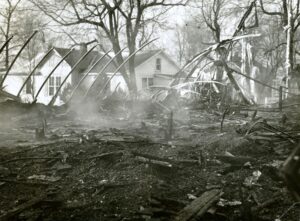 Culver’s most disastrous fire in many years totally destroyed St. Mary’s of the Lake Roman Catholic Church at the corner of College Avenue and Plymouth Street early Thursday morning.
Culver’s most disastrous fire in many years totally destroyed St. Mary’s of the Lake Roman Catholic Church at the corner of College Avenue and Plymouth Street early Thursday morning.
The loss was $25,000, fully covered by insurance. The original Catholic Church in Culver met a similar fate in 1905.
Aroused by barking dogs at about 5:30 a.m. Mr. And Mrs. Sam Strang, 122 College Avenue, were the first to discover the roaring pyre.
When the Culver Fire Department arrived in quick order the Quonset-type metal and laminated wood building was a mass of flames and the heat was intense.
Firemen from Knox, Monterey, and Plymouth soon joined in the heroic battle to control the conflagration and successfully kept it from spreading to the surrounding homes.
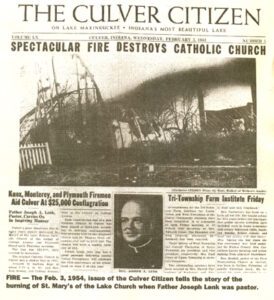 Only the gutted vestibule of the 72 X 36 foot building still stands. The church was built in December 1948 when Father Joseph A. Lenk first came to Culver.
Only the gutted vestibule of the 72 X 36 foot building still stands. The church was built in December 1948 when Father Joseph A. Lenk first came to Culver.
Cause of the fire is still undetermined but a faulty space heater may have been responsible. Father Lenk found everything in order when he left the church at 10 p.m. Wednesday.
Father Lenk lost many cherished personal belongings in the tragedy, including a chalice given him by his parents at his ordination as well as several mementoes from Army service.
Until a new church is built Catholic services will be held at the El Rancho Theatre on Sundays at 8:30 and 10 a.m. Holy Mass will be celebrated on weekdays at the rectory on College Avenue.
Basic construction cost of a new Catholic Church in Culver has been placed at $165,000, according to previous announcement.
The ultimate cost of the proposed church and St. Thomas More off-campus club will be $250,000. The church will have a seating capacity of 310.
Father Lenk, who also has a great personal following among Culver Protestants, will celebrate the 15th anniversary of his priesthood on June 3 of this year.
If there had been any serious thought that the fire was arson, it wasn’t voiced in media coverage of the conflagration. Protestant attitudes towards Catholics in America had evolved a great deal since the days of 1920s Indiana, when the Ku Klux Klan gained power in the statehouse and swelling numbers (it is said that one in every three white, male, Protestant Hoosiers was a member of the group between 1921 and 1925), largely on an anti-immigrant, anti-Catholic platform.
Nonetheless, during Fr. Lenk’s early years in Culver, some residents recall a cross being burned on his lawn (no local press coverage exists, however). It does appear there was some negative reaction to the arrival of a permanent Catholic parish in Culver.
Coverage in the local paper was supportive, however. In the same Culver Citizen newspaper that reported the fire, Fr. Lenk took a moment to address readers:
At a time like this I am reminded of the challenging words of Father Sorin, the founder of the University of Notre Dame, who, after the institution had been razed by fire for the third time, said to the brothers of the Holy Cross Order and the priests on the faculty: “If everything were gone we would still rebuild.”
We have our faith, our health, our talent, our people. The Catholic Church is composed of people, not real estate. There is only one way to look: ahead.
With confidence in Almighty God and in our own ability, coupled with the warm hearts of people of all faiths, we can look forward to a beautiful new church in the foreseeable future.
I am particularly grateful for the kindly interest of Culver’s ministers, the splendid work of our local firemen, and the fine expressions of our non-Catholic friends. I have witnessed a solidarity in our community spirit that is a genuine inspiration to me. In my six years in Culver I have not seen its equal. Thank you all.
CULVER MILITARY ACADEMY, LAKE MAXINKUCKEE RESIDENTS RALLY
Indeed, the fire that consumed St. Mary of the Lake church in January, 1954, rather than signaling a disaster for the parish, instead brought about the construction of the structure that stands today.
The article noted that, “Since the reorganization of the Culver parish, it has been meeting in the library auditorium most of the time, with the community building being used when the number of Culver Summer School boys required the move a room with a larger seating capacity.”
From its inception in 1894, Catholic Mass was not celebrated on the campus of Culver Military Academy, which emphasized a “non-sectarian” education (a coded means of stating, in those early years of the 20th century, that a private school was not only non-Catholic, but generally Protestant without an emphasis on one denominational outlook). All students attended Protestant chapel on Sunday mornings, regardless of religious affiliation, which likely lessened the number of Catholic students attending the school in its earlier years.
By the late 1940s and early 1950s, particularly with the growth of commercial air travel, numbers students from heavily Catholic countries began to swell at Culver Military Academy, creating a greater need for access to the Mass and other sacraments for students there.
Lenk began visiting campus regularly to lead catechetical instruction,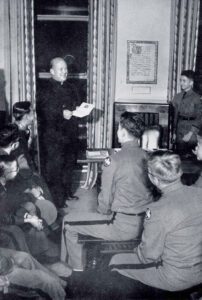 particularly towards Confirmation for CMA students, and his efforts facilitated a special Mass at St. Mary’s exclusively for Catholic students at the Academy, who had to be bused to the parish each week In addition to attending Protestant chapel.
particularly towards Confirmation for CMA students, and his efforts facilitated a special Mass at St. Mary’s exclusively for Catholic students at the Academy, who had to be bused to the parish each week In addition to attending Protestant chapel.
Lenk also eventually oversaw creation of the St. Thomas Moore Club in the basement of St. Mary’s church, at the time of the new church’s construction. The Club functioned as a social and religious gathering place for Academy students and their families, and Catholic students were allowed to spend time there on Sunday evenings (which for a time drew some ire from non-Catholic students wishing for the same opportunity).
By all accounts, Lenk was acutely aware of the unique makeup of the Culver-Lake Maxinkuckee community, and he formed close ties with the summer cottagers around the lake, both Catholic and Protestant alike (he eventually owned his own cottage on the lake called Villa Maria, at 920 South Shore Dr.), in addition to Culver Academy families.
These he leveraged to great advantage following the 1954 destruction of the first St. Mary’s, so that funds for the beautiful, new brick church came not only from local “year-round” Catholic families, but from lake residents and Academy families as well.
Lenk showed his appreciation for the area’s summer residents each year by erecting a small Christmas tree at the close of the summer season and offering Christmas greetings to lake residents he knew would be absent from their summer parish when December rolled around.
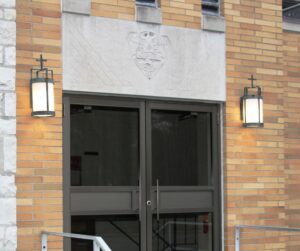 The connection between Culver Military Academy and St. Mary of the Lake — both in matters spiritual and material — is evident in the bas relief over the east entrance to the parish…that is, the doorway which faces Culver Academies: the seal of the school, with an eagle and Culver “C” logo, greet parishioners in bas relief as they enter the building.
The connection between Culver Military Academy and St. Mary of the Lake — both in matters spiritual and material — is evident in the bas relief over the east entrance to the parish…that is, the doorway which faces Culver Academies: the seal of the school, with an eagle and Culver “C” logo, greet parishioners in bas relief as they enter the building.
CMA students (and, after the 1971 inception of Culver Girls Academy, then Culver Academy for Girls, young ladies from that school as well) continued to be bused to the parish for Mass each week until the 1980s, when weekly Masses were finally offered in the majestic Memorial Chapel, erected in 1951 on the Academies’ campus.
The change marked the end of an era and a much closer relationship between school and parish, though it also helped foster a more localized Catholic community for Academies’ students (today, the school employs its own Catholic Youth Minister to work in conjunction with the parish priest, who says Mass each Sunday and assists with the sacraments as needed).
The old St. Thomas More Club of the St. Mary’s basement is long since a thing of the past, though the statue of its patron saint still stands inside the east entryway, a reminder of days gone by. 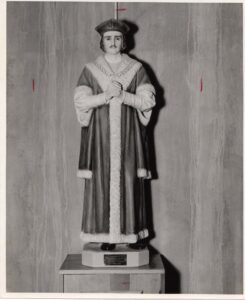
The demographic makeup of the Culver community has changed considerably as well. From the days when it might rightly be said that Culver was largely a “Methodist town” (though other Protestant denominations certainly persisted here), a number of Catholic residents became part of the parish in the form of retirees and second home owners from other areas of the state and other states, and a growth in number of Catholic faculty and staff at Culver Academies, in addition to growth in local year-round Catholic families in the town and its rural surroundings.
GENESIS OF THE ST. MARY OF THE LAKE OF TODAY
In July, 1954, the cornerstone of the current St. Mary of the Lake church was laid in “impressive rites,” as reported in The Culver Citizen. The edifice, it was noted, cost some $250,000 and could seat 310 people.
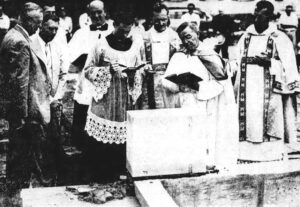 The event, overseen by Fr. Lenk, included blessing of the cross and cornerstone, placing of the cornerstone in the foundation wall, prayers and blessings, and the recitation of the Liturgy of the Saints.
The event, overseen by Fr. Lenk, included blessing of the cross and cornerstone, placing of the cornerstone in the foundation wall, prayers and blessings, and the recitation of the Liturgy of the Saints.
Other participants included the Rt. Rev. Msgr. Charles J. Feltes, chancellor of the Ft. Wayne Diocese, Fr. Giltmane of Divine Heart seminary at Donaldson (a many years-defunct seminary in proximity to the Poor Handmaids convent adjacent to today’s Ancilla College, northwest of Culver), Fr. Leander O. Carm of Chicago, and Fr. Cis of St. Dominic’s Church, Bremen. The ladies of the Altar Rosary Society served cake and ice cream on the rectory lawn during the social hour which followed the dedication, it was notes. 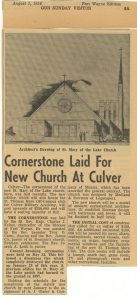
Among items placed in the cornerstone, according to the Citizen, were: A copy of Our Sunday Visitor, a leading paper of the Roman Catholic world, published in Huntington, Ind.; a copy of the 60th anniversary issue (July 14) of The Culver Citizen; a silver dollar – the coin of the realm; a history of St. Mary’s Church, 1897 to date; names of members and special friends of St. Mary’s Church; a medallion of the Blessed Virgin Mary, patroness of the church; a melted portion of the aluminum siding from the January fire; a melted portion of chalice and ciborium after recent fire; shield of the Culver Military Academy; three catalogs of the Culver Military Academy containing names of staff personnel; a list of officers and members of The Lake Maxinkuckee Association; a historical sketch of Medland & Bowman, Logansport architects and engineers; names of A. J. Glaser & Co., Muncie contractor and all individuals working on the structure.
The Citizen noted that Catholics and Protestants alike joined in the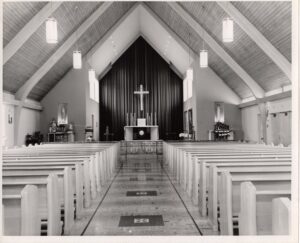 celebration at the dedication of the new church in August, 1955. Ft. Wayne Diocesan Bishop Leo Pursley led the dedication ceremonies, which also included Fr. Frederick Schroeder of Union City, Ind.; Fr. Charles Remaklis of Monterey; Fr. Paul O’Brien of the Divine Heart Seminary at Donaldson, and the Color Guard of the 4th Degree Knights of Columbus.
celebration at the dedication of the new church in August, 1955. Ft. Wayne Diocesan Bishop Leo Pursley led the dedication ceremonies, which also included Fr. Frederick Schroeder of Union City, Ind.; Fr. Charles Remaklis of Monterey; Fr. Paul O’Brien of the Divine Heart Seminary at Donaldson, and the Color Guard of the 4th Degree Knights of Columbus.
Fr. Lenk said the solemn high mass for the occasion, which facilitated a standing room only crowd. Singing for the mass was the Schola Contorum of SS. Peter and Paul Cathedral of the Archdiocese of Indianapolis directed by Lake Maxinkuckee summer resident Elmer Steffen.
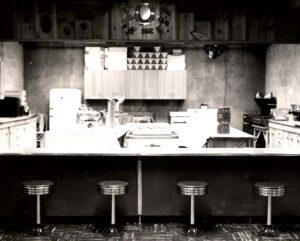
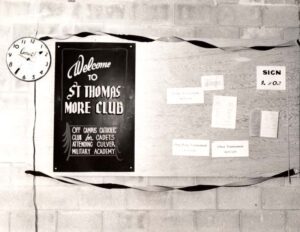
The following banquet and speaking program, in the church basement, included 465 attendees (“making it the largest formal dinner ever held in Culver,” according to the Citizen), with Col. A.J. Donnelly, assistant dean of Culver Military Academy, acting as toastmaster. Also on hand were W.O. Osborn, president of Culver’s State Exchange Bank, and Culver Military Academy superintendent W.E. Gregory, among a host of local and regional dignitaries.
The Citizen noted Bishop Pursley’s sermon during the mass was “challenging and forceful,” and the bishop then “ordered” Fr. Lenk to take a “much-deserved” vacation through the month of September.
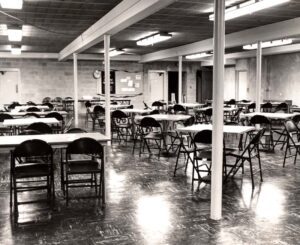
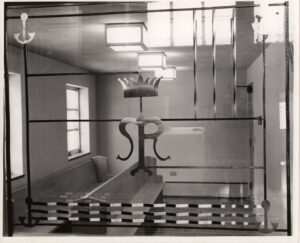
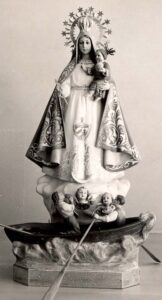
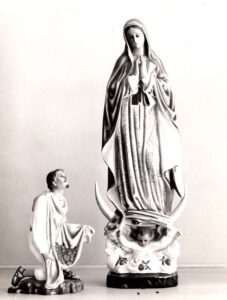
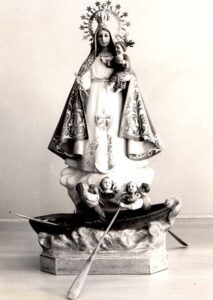
PARISH LIFE TO TODAY
In the years following the opening of the new church building, its front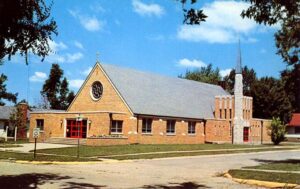 doors were famously painted red at Lenk’s order, signifying the ongoing debt incurred for the edifice. In June, 1971, the doors were finally painted green to signify liquidation of the mortgage debt.
doors were famously painted red at Lenk’s order, signifying the ongoing debt incurred for the edifice. In June, 1971, the doors were finally painted green to signify liquidation of the mortgage debt.
Two years later, in Aug., 1973, a silver anniversary celebration for the parish (dating it from 1948) was held at the church.
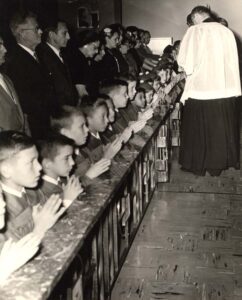
Fr. Lenk continued as pastor at St. Mary’s until ill health forced his early retirement in February of 1978 (he died in 1993, a scholarship for students from the parish to attend St. Joseph College in Rensselaer established in his name).
Lenk was succeeded in 1979 by Fr. Mathew Kafka, who shepherded the parish until being appointed pastor at St. Hedwig in South Bend in 1986.
Fr. Steve Morrison followed from 1986 to 1989; he was succeeded by Fr. Leonard Chrobot until 1991.
Fr. Jeffrey Largent was appointed pastor in 1991, serving at St. Mary’s and as a State Police chaplain until 2001.
Between 2001 and 2009, Fr. Glenn Kohrman oversaw the parish as its priest. His tenure was followed by that of Monsignor Thaddeus Balinda from Uganda, who was parish priest until 2013.
It’s rare for a parish priest to return to the same parish he served for several years, but in 2013, Fr. Largent returned as pastor of St. Mary of the Lake. He died of cancer in 2016, and a handful of priests assisted in interim roles until the assignment of Fr. William Meininger as St. Mary’s pastor starting in June, 2017. Fr. Stephen Felicichia’s tenure began in the summer of 2023.
